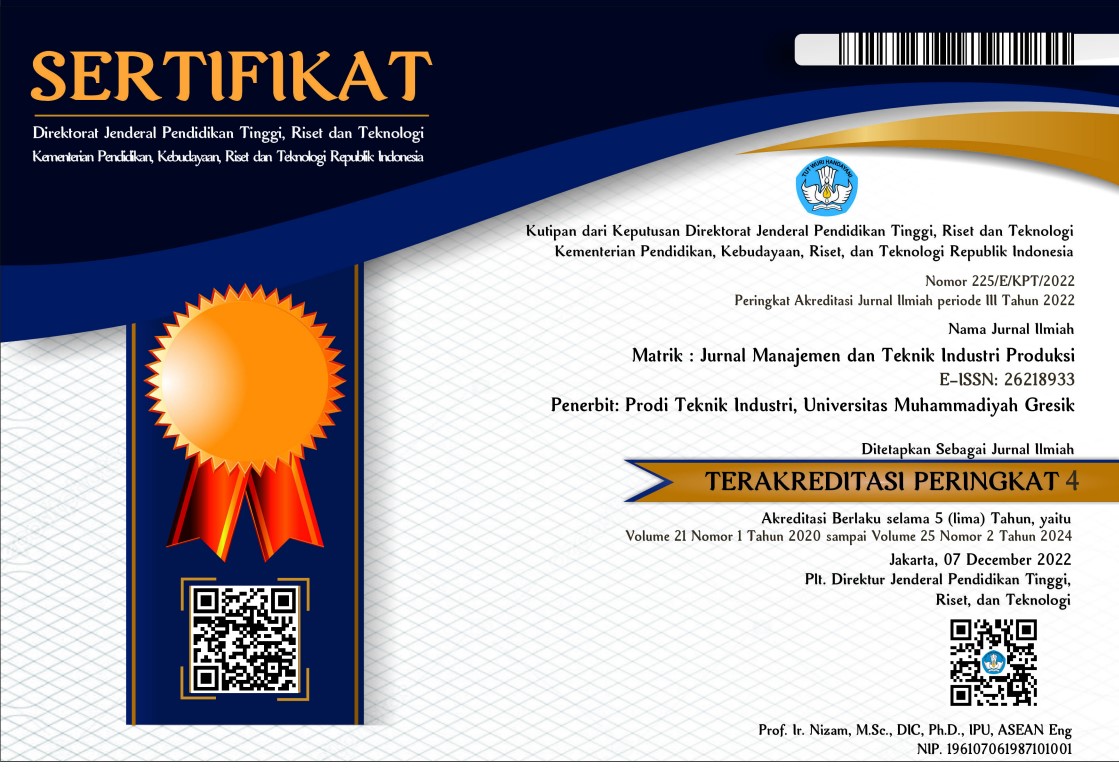Mitigasi Risiko Untuk Meningkatkan Kualitas Produk Pada Proses Produksi Pinting Cup
DOI:
https://doi.org/10.30587/matrik.v24i2.6808Keywords:
produk cacat, Failure Mode and Effect Analysis (FMEA), House Of Risk (HOR), mitigasi risikoAbstract
Utama Cup Printing merupakan salah satu perusahaan yang berbentuk industri rumahan dan bergerak dibidang sablon. Permasalahan yang ada di perusahaan ini yaitu banyaknya terdapat produk cacat yang dihasilkan pada setiap produksi sehingga menyebabkan kerugian dan menurunkan kualitas dari produk tersebut. Hasil produk cacat yang ditemukan pada bulan Oktober 2021 – September 2022 mencapai 5% dan melebihi batas toleransi perusahaan yaitu 2% dengan 8 jenis cacat produk. Penelitian ini ditujukan untuk mengidentifikasi risiko dan smber dari risiko tersebut sehingga mampu meminimalisir kecacatan dengan melakukan memberi usulan aksi mitigasi. Setelah diakukan identifikasi risiko didapatkan 11 kejadian risiko Utama Cup Priting. Terdapat 3 risk agent prioritas yang diberi aksi mitigasi yaitu A2 Screen yang digunakan bocor, A4 Terdapat kerusakan dan kesalahan settingkomponen mesin, A8 Operator memasukkan cup yang sudah tersablon 2 kali ke molding. Terdapat 5 aksi mitigasi yang dapat dilakukan perusahaan untuk meminimalisir risiko cacat yaitu PA1 Melakukan pemeriksaan dan perawatan layar screen setelah selesai digunakan, PA2 Melakukan pemeriksaan dan pemeliharaan rutin terhadap setiap komponen mesin produksi minimal 1 kali dalam 1 bulan, PA3 membuat SOP produksi (tertulis), PA4 Meningkatkan kualitas SDM (Sumber Daya Manusia) di Utama Cup Printing dengan cara menerapkan pelatihan screen printing pada karyawan, PA5 melakukan breafing sebeum memulai produksi.
References
[2] S. Perdana, “Analysis of supply chain risk mitigation strategies in the Bogor compressor company with the house of risk method,” IOP Conference Series: Materials Science and Engineering, vol. 852, no. 1. 2020. doi: 10.1088/1757-899X/852/1/012094.
[3] M. Ulfah, “Proposed supply chain risk mitigation strategy of chicken slaughter house PT X by house of risk method,” MATEC Web of Conferences, vol. 218. 2018. doi: 10.1051/matecconf/201821804023.
[4] D. P. Sari, “Business Feasibility Analysis of Sumedang Tofu MSMEs with Value Engineering Approach,” J. Econ. Bus. Ind., vol. 1, no. 1, pp. 20–31, 2023.
[5] R. Gustiari, “JEBIN Journal of Economics Business Industry”.
[6] H. L. Ma, “A fuzzy-based House of Risk assessment method for manufacturers in global supply chains,” Ind. Manag. Data Syst., vol. 118, no. 7, pp. 1463–1476, 2018, doi: 10.1108/IMDS-10-2017-0467.
[7] E. Kusrini, “Risk Mitigation Strategy Using the House of Risk (HOR) Method for Organic Farming Supplier in Sustainable Supply Chain,” 2021 International Conference on Data Analytics for Business and Industry, ICDABI 2021. pp. 486–492, 2021. doi: 10.1109/ICDABI53623.2021.9655956.
[8] C. Avila-Arteaga, “Supply chain management based on house of risk: A case study in a peruvian banana company,” Advances in Intelligent Systems and Computing, vol. 1253. pp. 513–519, 2021. doi: 10.1007/978-3-030-55307-4_78.
[9] T. M. Sari and W. Dini, “Risk Assessment and Mitigation Strategy in The Halal Broiler Supply Chain,” J. Ris. Ilmu Tek., vol. 1, no. 1, pp. 13–24, 2023.
[10] I. N. Permadi and D. B. Nisa, “A Model Experiment Design Using the Taguchi Method: A Case Study Of Making Concrete Roof,” J. Ris. Ilmu Tek., vol. 1, no. 1, pp. 36–44, 2023.
[11] G. Filhaq, S. Aprianto, and H. Alfianto, “Design of Smart Locker Door Using Quality Function Deployment Based on ATMega 2560 Microcontroller,” J. Ris. Ilmu Tek., vol. 1, no. 1, pp. 25–35, 2023.
[12] S. Yahya, “RISK ANALYSIS of SHIP COLLISION in INDONESIAN WATER USING HOUSE of RISK,” J. Eng. Sci. Technol., vol. 16, no. 6, pp. 5044–5059, 2021, [Online]. Available: https://api.elsevier.com/content/abstract/scopus_id/85122175452
[13] R. Hendayani, “Analysis of the House of Risk (HOR) Model for Risk Mitigation of the Supply Chain Management Process (Case Study: KPBS Pangalengan Bandung, Indonesia),” 2021 9th International Conference on Information and Communication Technology, ICoICT 2021. pp. 13–18, 2021. doi: 10.1109/ICoICT52021.2021.9527526.
[14] A. D. P. Citraresmi, “Risk measurement of supply chain for soy sauce product,” IOP Conference Series: Earth and Environmental Science, vol. 475, no. 1. 2020. doi: 10.1088/1755-1315/475/1/012058.
[15] A. Dharana, “Risk analysis in mini container loading and unloading activities at dock company,” Proceedings of the International Conference on Industrial Engineering and Operations Management. pp. 1878–1884, 2021. [Online]. Available: https://api.elsevier.com/content/abstract/scopus_id/85121100216
[16] F. Pohan, I. Saputra, and R. Tua, “Scheduling Preventive Maintenance to Determine Maintenance Actions on Screw Press Machine,” J. Ris. Ilmu Tek., vol. 1, no. 1, pp. 1–12, 2023.
[17] H. A. Ramadhan, “Determinants of Economic Value Addition of Industrial Tuna Fish Processors in the Sea Food Processing Sub-Chain in Malaysia,” J. Econ. Bus. Ind., vol. 1, no. 1, pp. 43–49, 2023.
[18] Yosritzal, “The analysis of supply chain risk logistics in implementation of West Sumatera - Riau toll road development,” IOP Conference Series: Earth and Environmental Science, vol. 340, no. 1. 2019. doi: 10.1088/1755-1315/340/1/012044.
[19] M. Asrol, “Risk management for improving supply chain performance of sugarcane agroindustry,” Ind. Eng. Manag. Syst., vol. 20, no. 1, pp. 9–26, 2021, doi: 10.7232/iems.2021.20.1.9.
[20] A. Muntoha, “Integrating House of Risk Method with PESTLE and CIMOSA for Risk Assessment of Java-Bali i Power Plant Construction Project,” IOP Conference Series: Materials Science and Engineering, vol. 598, no. 1. 2019. doi: 10.1088/1757-899X/598/1/012044.
[21] M. F. R. Dewantari, “Design Mitigation and Monitoring System of Blood Supply Chain Using SCOR (Supply Chain Operational Reference) and HOR (House of Risk),” IOP Conference Series: Materials Science and Engineering, vol. 982, no. 1. 2020. doi: 10.1088/1757-899X/982/1/012058.
[22] A. Alvina, “Application of Quality Control and Risk Management in Maintaining Product Quality with A Risk Breakdown Structure Approach,” J. Ris. Ilmu Tek., vol. 1, no. 2, pp. 89–101, 2023.
[23] F. Alamsyah and D. Sutoyo, “Redesign of Standard Paddock Motorcycle Products Using the Quality Function Deployment (QFD) Method,” J. Ris. Ilmu Tek., vol. 1, no. 2, pp. 78–88, 2023.
[24] H. Kamil, M. Mukhlis, and Y. Bachtiar, “Integration of ANP and TOPSIS Methods in Prioritizing Sales Strategies for Frozen Food Products,” J. Ris. Ilmu Tek., vol. 1, no. 2, pp. 102–114, 2023.
[25] R. Erwanda, “Layout Design of Copra Factory Facilities in Small and Medium Industry Centers Using Systematic Layout Planning Method,” J. Ris. Ilmu Tek., vol. 1, no. 2, pp. 115–127, 2023.
[26] P. S. Felicia and N. Zaitun, “Design a Patient Medical Record Application to Shorten Registration Time Using the Waterfall Model,” J. Ris. Ilmu Tek., vol. 1, no. 2, pp. 62–77, 2023.
[27] G. A. Sihotang and F. A. Damiyati, “Minimizing Fresh Fruit Bunches Inventory Costs Using Continuous Review System and Blanked Order System Methods,” J. Econ. Bus. Ind., vol. 1, no. 1, pp. 32–42, 2023.
[28] G. El Safira, Y. Sari, and D. Waluyo, “Virgin Coconut Oil (VCO) Business Analysis in Terms of Economic Income,” J. Econ. Bus. Ind., vol. 1, no. 2, pp. 56–62, 2023.
[29] K. Earnshaw, “Relationship Between Supply Chain Management and Competitor Intensity in The Food Business: A Structural Equation Model,” J. Econ. Bus. Ind., vol. 1, no. 2, 2023.
[30] J. Rismawati and N. O. Gultom, “Quality Analysis of Health Center Service Management for Efforts to Improve Patient Satisfaction,” J. Econ. Bus. Ind., vol. 1, no. 2, pp. 71–80, 2023.
[31] I. Sakinah, Z. Zahro, and A. Andinia, “Adaptation of Blue Ocean Strategy in Increasing Business Markets,” J. Econ. Bus. Ind., vol. 1, no. 2, pp. 81–91, 2023.
[32] I. O. Ozumba and E. Okon, “The Influence of Marketing Mix Strategy on Bread Customer Satisfaction in Nigerian Market,” J. Econ. Bus. Ind., vol. 1, no. 2, pp. 47–55, 2023.







